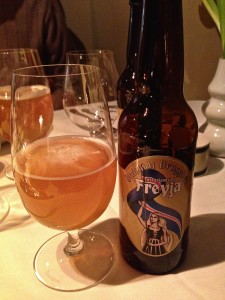A country that boasts the purest water in the world should apply that resource to the highest ends. Instead, Iceland has long maintained that its water produces the best coca-cola in the world – indeed Icelanders consume the most per capita – while outlawing beer for 73 years.
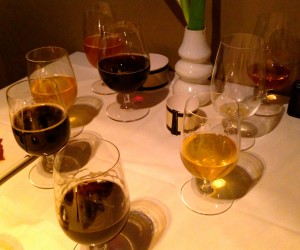
The world’s oldest extant parliament is not to blame for this blunder: in its very first referendum ever, the Icelandic population voted in favor of prohibiting all alcohol in 1908. The law became effective in 1915, but remained in full operation only until 1921, when the Spaniards refused to buy Icelandic fish – the main export – until Icelanders agreed to import Spanish wines. In 1933 another referendum legalized spirits, but teetotalers were able to maintain the prohibition on beer (with alcohol content greater than 2.25%), with the argument that beer would lead to depravity because it was so much cheaper than spirits. The success of the teetotaler argument is particularly surprising given that Iceland’s national spirit, Brennevin, is 40% alcohol and goes by the name “black death.”
There were attempts to counter the temperance movement, resulting in a brewing exception for American and British soldiers stationed in Iceland during WWII. Additionally, a businessman brought a lawsuit to demand the rights enjoyed by airline crews who could bring in a certain allowances of duty-free beer. While his suit was unsuccessful, the publicity resulted in a new rule that allowed Icelanders traveling abroad to bring in 12.2 pints of foreign beer.
The Alþingi itself voted to legalize beer in 1989 with a 13-8 vote in a full turnout of the upper house. In the end, the (currently un-)mighty Kroner carried the day, as Prime Minister Steingrimur Hermansson argued that beer sales taxes could help reduce Iceland’s budget deficit.
It took time, but the craft beer movement has taken hold of Iceland, and its pure water. On a recent trip to Reykjavik and the south coast of Iceland, I allowed that movement to take hold of me. Not at all a teetotaler, and not at all depraved, I managed to sample several styles from Icelandic brewers:
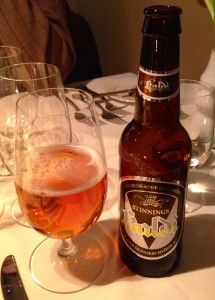
Stinnings Kaldi is produced by Bruggsmiðjan, a couple-run brewery in Árskogssandur. Agnes Anna and Olafur Trostur brew the beer with a Czech recipe, but they incorporate Icelandic ingredients including Angelica mountain herbs. The herbs create a woody and herbal flavor, which is rounded out by biscuit malt notes and a dry sour finish. Kaldi, which means cold or cool in Icelandic, would be a nice warm weather option with its light body and medium carbonation.
Freyja – named after the Norse goddess of fertility – is a Belgian-style wheat beer from Ölvisholt Brugghús in Selfoss. It pours a hazy golden color with notes of citrus and coriander spice. I can imagine it as a quenching summer beer.
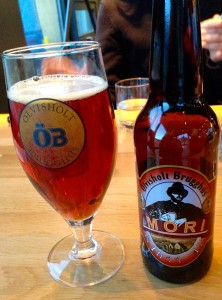
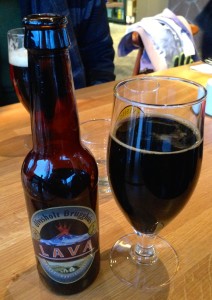
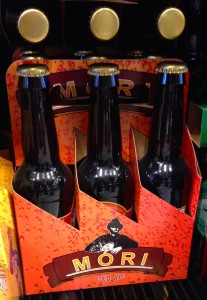
Ölvisholt Brugghús also produces Mori Red Ale and Lava, a smoked imperial stout. Mori smells primarily of sweet malts, and its taste follows accordingly, with notes of caramel, citrus and pine. The tongue feels a decent dose of carbonation, and a bitter finish. Some bitterness is appropriate for a beer that the brewery describes as a tribute to a boy who sought refuge from the cold after escaping a volcanic eruption, only to be refused shelter by a local farmer and left with no choice but to freeze to death and forever haunt the farmer and his descendants.
Lava, the darker beer without the dark story, pours an opaque black and is all smoothness, sweet chocolate, roasted malts, and smokey coffee flavors, rounded out with alcohol esters (at 9.4% ABV).
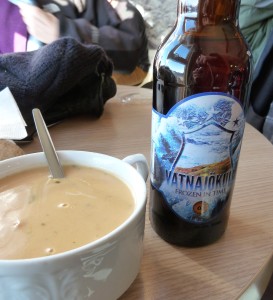
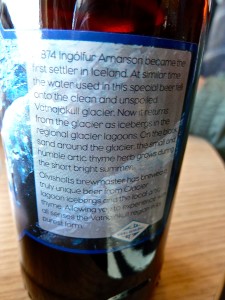
Vatnajökull Frozen In Time beer, yet another Ölvisholt Brugghús brew, offers a tourist attraction in itself, incorporating water from the floating icebergs of the Jökulsárlón glacier lagoon and local thyme spice. The beer is sweet with flavors of dried fruit, caramel, honey, and a heavy dose of thyme that makes the flavor unique.
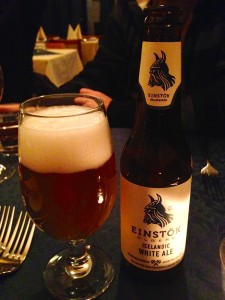

Einstock Brewery, located in Akureyri, functions as the experimental arm of Iceland’s Viking Brewery. It brews its Icelandic White Ale as a classic Belgian witbier, with orange peel and coriander, producing a light, carbonated, very drinkable beer.
Þvörusleikir Nr. 28 is a holiday amber ale brewed in Reykjavik by Borg Brugghús, the experimental arm of Egill Skallagrímsson Brewery. Its holiday spice seemed to focus on pepper and cinnamon, accompanied by malty toast, earthy hops, and peach flavors.
Viking Brewery markets its Black Death as an English Stout. The brew appears very dark in color, but feels lighter in the mouth than you’d expect. However, the flavor is rich and sweet, with tastes of smoked malt and roasted coffee.
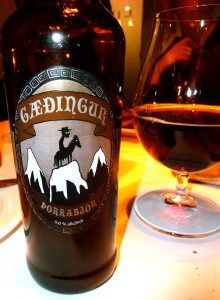
Þorrabjór 2015 from the Gæðingur Öl Brugghús, a delicious English Brown Ale, was probably my favorite beer of the trip. It pours closer to the thickness and color of a porter, and the mouthfeel is quite smooth. The brew tastes of caramel, roasted malts, and coffee, starting out sweet and finishing with a very slight bitter note.
For better or for worse, the ready availability of craft beer at many establishments allowed me to sample a satisfying variety of brews. I was impressed by the diversity of styles and the efforts by Icelandic brewers to incorporate local ingredients into their recipes. For all their talk about pure water, it’s about time Icelanders realized that the real “depravity” of beer was in its 73 year absence.

